One of the easiest ways to introduce children’s books in the classroom is to celebrate an author’s or illustrator’s birthday along with reading one from his or her books. Here are some Fall birthdays featured on the Children’s Book-a-Day Almanac; each features an essay about one of the books created by this talented group.
Tomie dePaola, Strega Nona
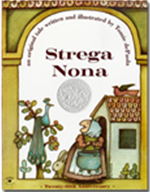 On Sept. 15, 1934, in Meriden, CT, a boy who would become one of the world’s best storytellers was born. Although any of Tomie’s 250 titles could be featured on the Almanac, my favorite remains his Caldecott Honor book, Strega Nona, published 35 years ago. Drawing on the magic cooking pot theme in folklore, Strega Nona features a grandmother with a magic touch. But when her assistant, Big Anthony, tries to duplicate her pasta-making spell, he overwhelms the town with a flood of spaghetti.
On Sept. 15, 1934, in Meriden, CT, a boy who would become one of the world’s best storytellers was born. Although any of Tomie’s 250 titles could be featured on the Almanac, my favorite remains his Caldecott Honor book, Strega Nona, published 35 years ago. Drawing on the magic cooking pot theme in folklore, Strega Nona features a grandmother with a magic touch. But when her assistant, Big Anthony, tries to duplicate her pasta-making spell, he overwhelms the town with a flood of spaghetti.
Bernard Waber, Lyle, Lyle Crocodile
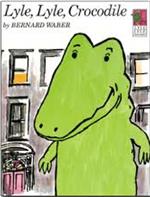 Sept. 27 is the birthday of one of the nicest human beings I ever had the chance to work with, Bernie Waber. In 1965, Bernie took a character that had appeared in another book, The House on East 88th Street, and starred him in his own story: Lyle, Lyle Crocodile. Lyle, a very well-behaved crocodile, lives with the Primm family on East 88th Street. But because of an unfortunate episode, Lyle finds himself incarcerated in the Central Park Zoo—and he just doesn’t cotton to all those other crocodiles.
Sept. 27 is the birthday of one of the nicest human beings I ever had the chance to work with, Bernie Waber. In 1965, Bernie took a character that had appeared in another book, The House on East 88th Street, and starred him in his own story: Lyle, Lyle Crocodile. Lyle, a very well-behaved crocodile, lives with the Primm family on East 88th Street. But because of an unfortunate episode, Lyle finds himself incarcerated in the Central Park Zoo—and he just doesn’t cotton to all those other crocodiles.
Donald Sobol, Encyclopedia Brown
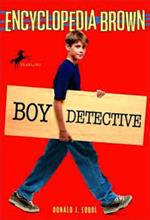 Born on Oct. 4, 1924 in New York City, Donald Sobol served in the Army Corps of Engineers in World War II and then attended Oberlin College. Shortly before his 40th birthday, Sobol published the first of the books that would make his fame and fortune, Encyclopedia Brown: Boy Detective. This book, like the sequels that would follow, contains 10 short but exciting stories about Leroy Brown, son of the police chief of Idaville, FL. Leroy is nicknamed “Encyclopedia” because of his vast knowledge, and he receives help or hindrance from Sally Kimball, his Watson, or Bugs Meany, his nemesis. In each story, the reader is asked to solve a mystery or question by logic, observation, or deduction. Ideal for readers not always enthusiastic about books, the stories have some of the same appeal as Sherlock Holmes sagas.
Born on Oct. 4, 1924 in New York City, Donald Sobol served in the Army Corps of Engineers in World War II and then attended Oberlin College. Shortly before his 40th birthday, Sobol published the first of the books that would make his fame and fortune, Encyclopedia Brown: Boy Detective. This book, like the sequels that would follow, contains 10 short but exciting stories about Leroy Brown, son of the police chief of Idaville, FL. Leroy is nicknamed “Encyclopedia” because of his vast knowledge, and he receives help or hindrance from Sally Kimball, his Watson, or Bugs Meany, his nemesis. In each story, the reader is asked to solve a mystery or question by logic, observation, or deduction. Ideal for readers not always enthusiastic about books, the stories have some of the same appeal as Sherlock Holmes sagas.
James Marshall, George and Martha
 Were he still living, I’d be sending birthday greetings to Jim Marshall on Oct. 10. He died at the age of 50, much too young and with too many great books still to come. One day, lying in a hammock back home in San Antonio, Jim was sketching and placed two small dots on a page. As he drew around those dots, he developed two ungainly hippos. Editors often tell writers to construct books about what they know. When Jim created the seven books about the delicate relationship of George and Martha, he definitely drew on his area of expertise: friendship. In George and Martha, George pours Martha’s split pea soup in his loafers so he doesn’t offend her. In George and Martha Encore,Jim delivers one of his signature lines, “But George never said ‘I told you so.’ Because that’s not what friends are for.”
Were he still living, I’d be sending birthday greetings to Jim Marshall on Oct. 10. He died at the age of 50, much too young and with too many great books still to come. One day, lying in a hammock back home in San Antonio, Jim was sketching and placed two small dots on a page. As he drew around those dots, he developed two ungainly hippos. Editors often tell writers to construct books about what they know. When Jim created the seven books about the delicate relationship of George and Martha, he definitely drew on his area of expertise: friendship. In George and Martha, George pours Martha’s split pea soup in his loafers so he doesn’t offend her. In George and Martha Encore,Jim delivers one of his signature lines, “But George never said ‘I told you so.’ Because that’s not what friends are for.”
Russell Freedman, Eleanor Roosevelt
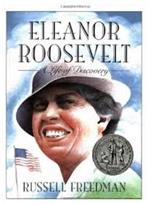 Oct. 11 marks the birthday of both Russell Freedman and Eleanor Roosevelt. Russell began writing books for young readers in the science and social studies area—books like How Animals Learn and Sharks. Of all Russell’s biographies, I always have loved his Eleanor Roosevelt best. Perfect for 10- to 14-year-olds—I needed this book as a child myself. I once made a fool of myself in class because I thought that “FDR” was a swear word—so vehemently was it used at home. Imagine my surprise when I found out these initials acknowledged a president of the United States. Russell has always admitted that he loved FDR’s wife a bit more than he loved the president, and the resulting tribute to her certainly shows his enthusiasm.
Oct. 11 marks the birthday of both Russell Freedman and Eleanor Roosevelt. Russell began writing books for young readers in the science and social studies area—books like How Animals Learn and Sharks. Of all Russell’s biographies, I always have loved his Eleanor Roosevelt best. Perfect for 10- to 14-year-olds—I needed this book as a child myself. I once made a fool of myself in class because I thought that “FDR” was a swear word—so vehemently was it used at home. Imagine my surprise when I found out these initials acknowledged a president of the United States. Russell has always admitted that he loved FDR’s wife a bit more than he loved the president, and the resulting tribute to her certainly shows his enthusiasm.
Ed Emberley, Ed Emberley’s Drawing Book of Animals
 Oct. 19 marks the birthday of Ed Emberley. Ed was born in Malden, MA, graduated from the Massachusetts School of Art, and then painted signs for the army and worked in commercial illustration. In the late 1950s, he began publishing books with the then-Boston firm of Little Brown and Company. For Ed Emberley, working on books was a family affair; he collaborated with his wife, Barbara, and his son, Michael, and daughter, Rebecca, have continued the fine family tradition.
Oct. 19 marks the birthday of Ed Emberley. Ed was born in Malden, MA, graduated from the Massachusetts School of Art, and then painted signs for the army and worked in commercial illustration. In the late 1950s, he began publishing books with the then-Boston firm of Little Brown and Company. For Ed Emberley, working on books was a family affair; he collaborated with his wife, Barbara, and his son, Michael, and daughter, Rebecca, have continued the fine family tradition.
Although Ed Emberley won the Caldecott Medal for Drummer Hoff, his fame and fortune really began in 1970 when he published Ed Emberley’s Drawing Book of Animals. Dedicated to “The boy I was, the book I could not find,” this book, and the subsequent volumes, make it possible for any child—and for that matter, any adult—to believe he or she can become an artist.
Bette Bao Lord, In the Year of the Boar and Jackie Robinson
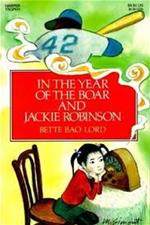 On Nov. 3, 1938, Bette Bao Lord was born in Shanghai, China. At the age of 8, she came to the United States with her father and mother and one sister. When Mao Zedong and his Communist party won the Chinese civil war, the Boas were stranded in the United States. Bette’s youngest sister, Sansan, had been left behind with relatives. The family struggled to get her out of China, a process that took more than a decade. In the Year of the Boar and Jackie Robinson began as a magazine article, but the author decided to change the perspective of her story, to tell it from a child’s point of view. In 1947, Chinese-born Bandit Wong, 10, must shift from being a pampered child in a very affluent family to an immigrant, struggling to fit in to Brooklyn P.S. 8. Her family still observes their Chinese customs, while she tries to understand the new American ones. As Bandit struggles with English, she finally realizes that the best way to connect with these strange Americans may well be through the sport of baseball—more exactly, with her classmates’ love of the Brooklyn Dodgers.
On Nov. 3, 1938, Bette Bao Lord was born in Shanghai, China. At the age of 8, she came to the United States with her father and mother and one sister. When Mao Zedong and his Communist party won the Chinese civil war, the Boas were stranded in the United States. Bette’s youngest sister, Sansan, had been left behind with relatives. The family struggled to get her out of China, a process that took more than a decade. In the Year of the Boar and Jackie Robinson began as a magazine article, but the author decided to change the perspective of her story, to tell it from a child’s point of view. In 1947, Chinese-born Bandit Wong, 10, must shift from being a pampered child in a very affluent family to an immigrant, struggling to fit in to Brooklyn P.S. 8. Her family still observes their Chinese customs, while she tries to understand the new American ones. As Bandit struggles with English, she finally realizes that the best way to connect with these strange Americans may well be through the sport of baseball—more exactly, with her classmates’ love of the Brooklyn Dodgers.
Astrid Lindgren, Pippi Longstocking
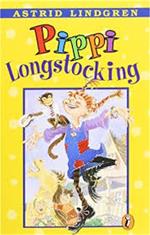 Born on Nov. 14, 1907, Astrid Lindgren grew up on a farm just outside Vimmerby, Sweden. Pippi Longstocking, the book for which she became world renowned, published in the United States 60 years ago, arose from stories she told her 7-year-old daughter. Pippilotta Delicatessa Windowshade Mackrelmint Ephraim’s Daughter Longstocking, or Pippi for short, lives without parents. Pippi dictates her own rules and nags herself about going to bed at night. With endless money, time, and freedom, she certainly fulfills the fantasy of most children who often think about what life would be like if they had no one to boss them around. After the manuscript was rejected by many publishers, Lindgren decided to enter Pippi’s story into a contest held by a Swedish publishing house. She won first prize! When Lindgren submitted the final version, she added a note: “In the hope that you won’t notify the Child Welfare Committee.” Pippi breaks so many of society’s rules that some reviewers disliked Lindgren’s story: “Pippi is something unpleasant that scratches the soul.”
Born on Nov. 14, 1907, Astrid Lindgren grew up on a farm just outside Vimmerby, Sweden. Pippi Longstocking, the book for which she became world renowned, published in the United States 60 years ago, arose from stories she told her 7-year-old daughter. Pippilotta Delicatessa Windowshade Mackrelmint Ephraim’s Daughter Longstocking, or Pippi for short, lives without parents. Pippi dictates her own rules and nags herself about going to bed at night. With endless money, time, and freedom, she certainly fulfills the fantasy of most children who often think about what life would be like if they had no one to boss them around. After the manuscript was rejected by many publishers, Lindgren decided to enter Pippi’s story into a contest held by a Swedish publishing house. She won first prize! When Lindgren submitted the final version, she added a note: “In the hope that you won’t notify the Child Welfare Committee.” Pippi breaks so many of society’s rules that some reviewers disliked Lindgren’s story: “Pippi is something unpleasant that scratches the soul.”
 With a unique career in children's books, Anita Silvey has served both as the editor of The Horn Book Magazine and as a publisher of a major children's book imprint. She is the author of several books, including Henry Knox: Bookseller, Soldier, Patriot and I’ll Pass for Your Comrade: Women Soldiers in the Civil War. Her latest project, The Children’s Book-a-Day Almanac, is an interactive website she describes as a “daily love letter to a book or author,” with each entry offering a glimpse into the story behind the story. Her columns are culled from the reviews on her website.
With a unique career in children's books, Anita Silvey has served both as the editor of The Horn Book Magazine and as a publisher of a major children's book imprint. She is the author of several books, including Henry Knox: Bookseller, Soldier, Patriot and I’ll Pass for Your Comrade: Women Soldiers in the Civil War. Her latest project, The Children’s Book-a-Day Almanac, is an interactive website she describes as a “daily love letter to a book or author,” with each entry offering a glimpse into the story behind the story. Her columns are culled from the reviews on her website.